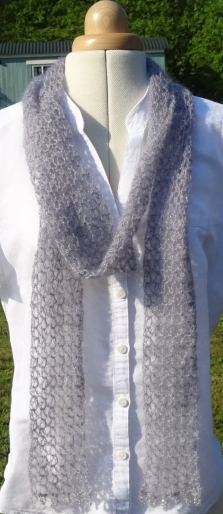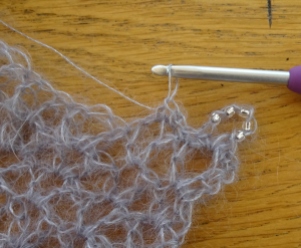This is the second and final week of the Cloud CAL. Here’s a recap of part 1.
The first stage of this part is to finish the end with a beaded edge.
Beading with crochet can be done several ways, one way is to thread the beads onto the yarn and then keep pushing them down the yarn as you work, bringing them up to the hook when needed. This design has beads only at the very ends of the scarf, so I thought it much better to just add them when needed, because I would have found it a bit of a faff to keep pushing beads down the yarn for so long so I am sure you would too!
The beaded edge is simple – a set of 6 loops with 5 beads on each. You could make these loops longer if you like, but I found 5 beads sufficient. If you don’t want to use beads then you can miss out some of the work – maybe just do a picot instead of the 5 beaded sts.
Are you ready? Well here we go:
Beaded row: 1ch (does not count as a st), 1dc in st at base of ch, 1dc in next tr, 1dc in next 1ch-sp….now the fun bit, we are going to do 5 ch with beads on them, as follows:
Slip a few beads on the small crochet hook:

Now remove the working hook from the loop, place the small hook on the loop and slide one bead down over the hook and onto the loop, remove the small hook and replace the working hook on the loop, make 1ch. You have trapped one bead in the ch. These photos show the technique:
Now repeat this process, removing the working hook, placing a bead on the loop and then completing the ch.
Do this until you have 5 beads trapped on the ch loop.
*Now work 1dc in the same 1ch-sp as the last dc, 1dc in each of next 2 tr, 1dc in the next 1ch-sp.
And repeat the 5 ch of beads.
Repeat from * until you have 6 loops of beads, then end with 1dc in last 1ch-sp and 1dc in the last st. Break yarn and fasten off.

You now have half a scarf!
To make the second half, re-join the yarn to the underside of your original starting ch (this is now the centre of the scarf), and then complete the second half to be identical to the first half.
Set up row: (this is basically the same as Row 2 from the first part) 2ch, (1tr, 1ch, 1tr) in first 1ch-sp, (1tr, 1ch, 1tr) in each of next four 1ch-sps, in the last 1ch-sp you do something slightly different: (1tr, 1ch, tr2tog placing first part in 1ch-sp and last part in last st on the Row), turn.
The first 2ch and 1tr together count as a tr2tog – so you start and end the row with a tr2tog which helps give a firm edge.
Next row: 2ch, *(1tr, 1ch, 1tr) in 1ch-sp; repeat from * to last 1ch-sp, in this last 1ch-sp you do something slightly different: (1tr, 1ch) in last 1ch-sp, now tr2tog placing first part in last 1ch-sp and second part in last st on the Row, turn. This is the pattern row and is repeated until the second half of the scarf is the same length as the first half, and then finish with the same beaded edge described above. And voila! You have a skinny summer scarf, light as a feather!

If you have any questions please ask on Ravelry or Facebook, and please share photos 🙂
I am working on my second scarf and hope to finish this weekend. So I will share a photo when it is done, until then Happy Crocheting! xxx









 I love my scraps blanket because of all the memories hooked into it, and I love the Stylecraft blanket because of the colours! But I have so many blankets at home that I decided I needed to find a good cause for the Stylecraft blanket. And I am so pleased to say that I found that cause through my friend Kathy. She supports many good causes through auctions and other fundraisers, and she was more than happy to find a way of raising funds from my blanket, in fact I think she was a bit gobsmacked that I could give away such a beautiful blanket! But I was so pleased that Kathy could help me 🙂
I love my scraps blanket because of all the memories hooked into it, and I love the Stylecraft blanket because of the colours! But I have so many blankets at home that I decided I needed to find a good cause for the Stylecraft blanket. And I am so pleased to say that I found that cause through my friend Kathy. She supports many good causes through auctions and other fundraisers, and she was more than happy to find a way of raising funds from my blanket, in fact I think she was a bit gobsmacked that I could give away such a beautiful blanket! But I was so pleased that Kathy could help me 🙂







